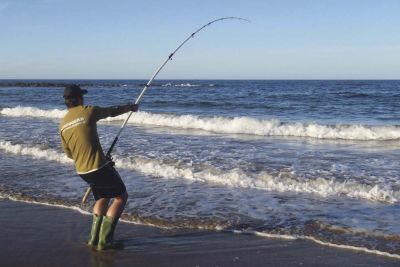 Presented from Issue 112, October 2014
Presented from Issue 112, October 2014
Burnie, the unofficial capital of the north-west coast, through the depths of Winter, can be dark and dreary. However it is still exceptionally productive on the angling front. While snow capped St. Valentines Peak and its surroundings, rain and wind pounded the coast for the majority of the cooler months. Surprisingly however, the fishing, particularly in the coastal rivers, has been encouraging. Now, as spring launches into effect and the conditions around us begin to warm, the fishing will only improve even more, preparing us recreational anglers for a very productive summer.
At the beginning of the cold snap that buried the highest reaches of the state in snow, after climbing a mountain or two, I decided to start hitting the local rivers mouths, creeks and other coastal haunts such as my childhood favourite Red Rock in Cooee and the Emu River, Fern Glade in particular. Targeting trout mostly, due to the opening of the season, I really found it difficult to get my first fish on the board!
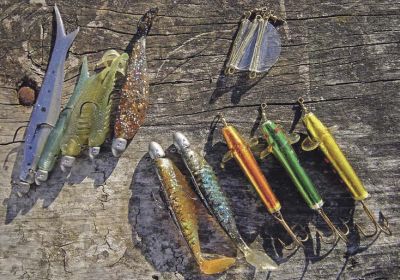 |
| A selection of lures that work for the author around Burnie. |
No sooner had I pulled up and set up my gear on my very first outing after work below the spillway at the Emu River, a daunting flock of cormorants flew overhead and landed on the beach adjacent to the patch of water I intended to fish. These weren’t the average black and white birds you see sitting on the edge of channel markers and jetties, these were the big Stuka-sized brown Velociraptor looking things. As you could probably expect, I didn’t see a fish there and I still haven’t to this day!
Accepting the fact that the shallow, open water I was fishing at the time was no place for a trout to even survive, given the plague of cormorants that now stalk the entirety of the river, like just about every river in the state, I decided to find deeper, more protected sections of the river to prospect. I found this option to be far more successful, especially in the upper reaches of the river where the water is deep and well protected. Now, if you intend on fishing the Fern Glade area, especially after heavy rainfall, never underestimate the garden worm! The garden worm is thy friend! I don’t care what anyone may think or say about soaking a worm for trout in particular, it’s a productive, relaxing way to fish, especially on a quiet sunny day.
First trout I eventually found my first trout at the Guide Reservoir, in the easiest possible spot to find a fish, the spillway! I’ve had some memorable sessions at the Guide over the years, but I can’t help but feel that the fishery isn’t up to quite up to scratch. Don’t get me wrong, there are still plenty of fish in there, but not of the same size and condition of a few years ago. The reservoir is reduced to little more than a puddle over the summer period and one could only expect this is a major factor in ultimately determining the fate of the whole ecosystem within the body of water. I can only hope as the season progresses, the fishing improves up there because it really can be a fantastic place to spend some time.
Pet Dam
Fishing much better than the Guide at the moment, is the Pet Dam. In my opinion, at the present moment, the Pet would be a much better place to spend the day. The fishing was incredible last year. I can remember a quick after work session where I met up with Mitchell Hardy and Bryce Purton just before sunset. I think we managed to find ten or eleven fish, maybe twelve, which were all in superb condition and played up better than any trout I’d ever pinned before. The eastern and western shores are both very productive, especially on a dark, overcast day or on sunrise or sunset. The Pet is also a good and productive spot to soak a grub or worm, so don’t rule that out as an option!
Lake Kara
Lake Kara, located up near Hampshire, has been a very popular destination for those wanting to chase Atlanitc salmon and rainbow trout so far this season. IFS regularly stock this considerably small system and it’s always worth a look up there, especially if you’re after a fresh feed of fish. It can get very crowded there at times, so if you plan to attack the lake, make sure you get there early! Similar to Brushy Lagoon, the fish will readily take just about anything. It’s a well known fact that these fish like anything pink, especially soft plastics. The dam wall is the best spot to find fish, but once again, make sure you get up there early otherwise you’ll struggle to find a place to stand, let alone cast a line!
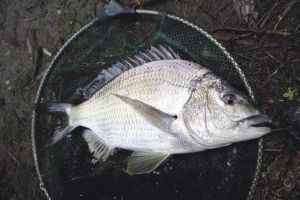 |
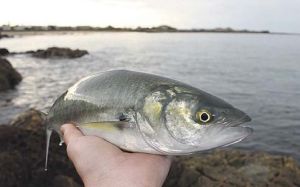 |
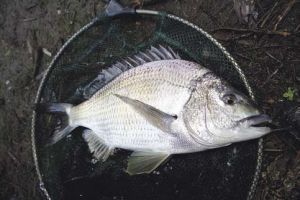 |
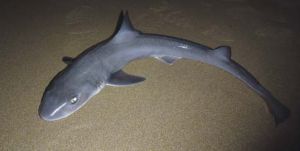 |
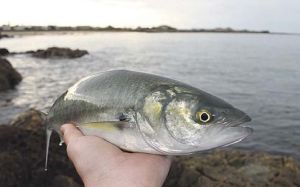 |
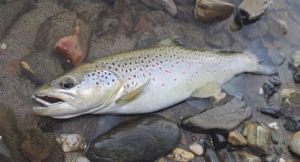 |
| A sample of fish caught near Burnie. |
Blythe River
The Blythe River has probably been my most favourite river system so far this season, with plenty of small ‘slob’ brown trout patrolling the mouth of the river, chasing the incoming whitebait. I haven’t seen too many cormorants there either, so that’s a positive sign. There are also plenty of mullet and juvenile salmon throughout the system and the odd silver trevally sniffing around below the highway bridge on an incoming tide. I haven’t really had a good crack at the Cam or Inglis so far this year, but I’d expect the sea running trout to be starting there annual pilgrimage upstream in search of the migrating whitebait. There is plenty of bait on the move at the moment so I predict we are in for a cracking season on the sea runners, not only on the north-west coast, but around the state!
As far as technique and tackle is concerned, I think everyone has there own personalised way to catch trout on the north-west coast these days and there is no right or wrong way to go about it. Personally, I find the good old green and gold Ashley Spinner is a classic for the Pet and the Guide, as are slightly weighted paddle tailed soft plastics in a natural colour like a green or a black. Spinner or plastic, a slow gentle retrieve with the occasional pause will do the trick for those fastidious trout. Rivers and creeks are much the same, but I usually stick with soft plastics in the deeper or fast flowing stretches of the system.
Saltwater Spring action
As spring progresses, the saltwater scene along the coast will explode into action. Expect big silver trevally, snapper, bream, barracouta and flathead to make an appearance very soon. You could sit back and write a book on the species that call the north-west coast they’re home, there are just so many of them. Bream have been my main focus over the last two years and finding them along the coast has been surprisingly easy. Nice sized blue spotted flathead and kingfish have also been an interesting and welcome addition to the growing species list!
Emu Bay
Emu Bay is probably the best spot in and around Burnie to target just about anything in the salt and briny. If you have access to a boat of kayak, the opportunities are truly endless. Shore bashing the bay is also productive, especially if you don’t mind a bit of a stroll. The breakwater is a fantastic piece of structure that attracts fish from inside and outside the bay. Snapper and snotty trevally are a common target species out there but the snotties have been a little quiet over the past few years. As usual, burley will be the key factor to your success. Anything from cat food to finely chopped bread will do, but I find a mixture of chicken feed and tuna/ fish oil is best suited for the fish that inhabit the bay.
Most of the fish you will encounter inside the bay can be caught on the ever productive paternoster rig. Don’t go overboard with heavy leader material, hook size and sinker weights. A twin dropper rig, consisting of two small long shanked hooks, a small bomb or barrel sinker and leader material with a breaking stain of about eight to twelve pounds will do the job perfectly. Carefully thread a piece of bait onto each hook and you will be ready to roll. You can use just about anything for bait in the bay. I like to use tough, oil rich baits, such as mullet or mackerel, which can be readily caught throughout the bay using a variety of techniques. Large calamari can also be found within the bay, mostly around wharf structure and weed beds and any slow sinking squid jig will work for them.
At anchor, sinking an unweighted bait down through the water column in your burley trail is also a good and probably one of the best methods to find fish in and around the bay, especially juvenile snapper, silver trevally, whiting and various other species. Most of the snapper you will encounter inside the bay will be undersize, so make sure you do the right thing and let them go so they can continue to grow into the big bumpy headed beasts we all want to catch!
Australian salmon
Australian salmon have made a their presence noticed along the coast, particularly off Penguin and Sulphur Creek, to the east of Burnie. As usual, these fish are best targeted using small to medium sized metal slices, soft plastics and small surface poppers, for those looking for the big surface show. Depending on what they’re eating at the time, whether its krill or baitfish, you may have mix your lure selection up a bit and as they say ‘match the hatch’. Whether targeting salmon from the shore or in a boat or kayak, you can always find a school or two patrolling river and creek mouths all along the coast. Blackman’s reef, to the west of the breakwater, is another popular spot for local anglers targeting salmon and a host of other quality table fish.
Shore based
Fishing from the shore around Burnie is just as good as anywhere in the state and if you put the time and effort to targeting a specific species, you will usually go home with a smile on your face. Popular land based locations include my personal favourite Red Rock in my home suburb of Cooee, the two jetties and the rock wall at the South Burnie Yacht Club, the rocky point across the road from Cooee Primary School on the Bass Highway, which is best fished at dead low tide and river mouths at the Emu, Blythe, Inglis and Cam. The paternoster rig can be used at any one of these productive ‘honey holes’, but a small bait suspended below a float or just a simple unweighted bait will work wonders too, especially with the surface dwelling critters like garfish and mullet.
Fishing from the beach will also improve as summer approaches. Gummies, elephant fish, rays and even the odd King George whiting will start to make an appearance once the Strait starts to warm up a bit. Just about every stretch of beach around Burnie will produce top notch fishing, especially during the night when gummy sharks come out to hunt and scavenge. The paternoster rig will work on the beach too, accompanied with fresh bait such as squid or mullet. Squid is probably a better option while fishing during the night as the sea lice will strip any fleshy bait to the skin in no time at all. Bump up your leader material and hook size to ensure you don’t get bitten or busted off by anything large and use a solid, weighty sinker to get those big long casts out past the surf and into the deep. Pyramid sinkers are a good option to have in the tackle box as they anchor your rig firmly in the one spot.
Burley is essential
Arriving at your selected stretch of beach while the tide is coming in is important as you can actually prepare a burley system that will disperse and take care of itself. Simply walk to the waters edge, dig a hole and fill it with a small amount of finely chopped fish scraps or a tuna oil and bread based mixture. Cover the hole lightly with sand and repeat as many times as you wish until you reach the high tide mark, where you will eventually be stationed as the tide rises. This method will ensure that you have a continuously dispersing burley trail that will attract fish from everywhere along the beach, plus you don’t have to carry a bucket or pot around with you!
From fishing out in the bay to having a quick cast from the shore, using burley is absolutely essential to any form of success, especially while targeting the more rare and prestigious species such as snapper, whiting and trevally. A long beach fishing rod of about ten to twelve feet long will do for the onshore bashing, particularly on the beach and your typical light soft plastics outfit that you use for trout will just about do for everything else, including fishing from the boat or ‘yak in and around Emu Bay. It’s common knowledge these days that braided lines are the best way to go, but make sure you suit the breaking strain to the style of fishing you intend to do.
Plastic fantastic
As far as soft plastics go for fishing around the big ‘B’ town, any natural looking profile will work, especially sandworm, prawn and baitfish imitations. Before selecting a suitable jighead for the job, make sure you examine the current, swell and wind conditions. If it’s reasonably settled, try and use a 1/12 or 1/8oz jighead, just so you’ve got plenty of hang time while your plastic sinks to the bottom. If the conditions are sloppy, chuck on something a little heavier, like a 1/6 or 1/4oz jighead, this will make your plastic sink quicker, but you’ll have constant contact with your plastic and you’ll be able to detect any touches or bites between wind gusts and waves . If you can persist with casting a plastic around occasionally, you’ll be hooked for life. You’ll catch plenty of good fish too!
Be responsible
On a serious note, remember to limit your kill and don’t go overboard while collecting bait and fish for the table, take only what you need for a feed! Also, make sure you don’t leave any rubbish around the place, or anywhere for that matter. It’s just a low act and other people shouldn’t have to deal with it. Recently, I was fishing a river and found a pile of toadfish that had been ‘ghetto stomped’ and left for dead on the bank. Why? Is it really necessary? Anyway, rant over, that’ll do for me for now.
Give Burnie a try
There are plenty of fantastic fisheries around Burnie that are yet to be discovered. The big ‘B’ town and its surroundings will have plenty to offer as we head full throttle into the warmer months and summer!
Daniel Paull




